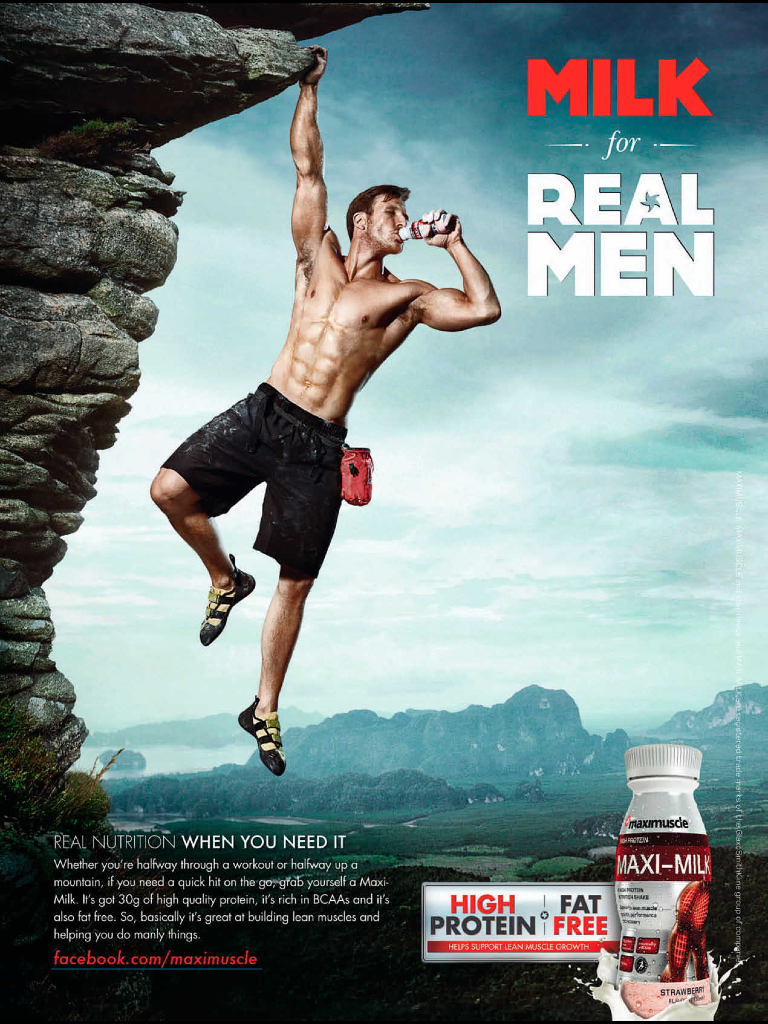Culture Jam
This is an advertisement for Maxi-Milk, a ready-to-drink protein shake by the company MaxiNutrition. It depicts a shirtless man hanging off of a cliff ledge with only one arm. The man has significant muscle definition, indicating that he’s highly athletic and fit. He is taking a drink of the Maxi-Milk. It looks like he’s wearing climbing shoes and has a pack on his hip, which could be full of chalk to make it easier to climb. The text on the ad says “Milk for Real Men” which suggests that this climber is a “real man.” This suggestion comes with the implication that a “real man” is extremely muscular, chiseled and enjoys extreme sports. The rest of the wording describes the product as “great at building lean muscles and helping you do manly things.” From this, I assume that the rock climbing is considered a manly thing. This advertisement is not only harmful in the aspect of body image for men, but it is also sexist. Touching the sexism briefly, the implication that rock climbing is a “manly” thing is unfair to the many women who enjoy climbing as well. Furthermore, claiming that the milk is for “real men,” eliminates any women from the target market which seems strange given that the product is just a protein shake, which is a product used by women as well. However, I chose to focus on the harmful body image expectations that this sets for boys and men. Obviously, the body type in the ad is not the average and is quite difficult to achieve. To claim that this is the image of a “real man” is harmful to boys and men who don’t look like this. It implies that they are not real men and sets an unrealistic expectation for their body image.
In my jammed ad, I aimed to make it very clear that this body type is unrealistic and also sets unfair standards for men to be considered “real men.” I replaced the “Real Men” part of the text with “Men who look like fitness models” because I think that’s what this ad depicts. This change is meant to reduce the harm the ad could do to the average man who does not look like this man at all. This product is not being marketed to the average man, it is being marketed to the small percentage of all men who look like fitness models. These kinds of images create body dysmorphia in young boys who believe that this is what they must look like to be considered “real men.” I altered the body of the man slightly as well: I made his arms and legs bigger and then reduced the size of his waist. I did this to emphasize the unrealistic shape of the body and how it is quite unattainable for most men. This body type is a version of the stereotypical body image that is plastered all over media. This image is what is marketed as ideal for men and it causes a lot of insecurity for these men because it is a very difficult body to achieve. The alteration of the body also relates to the text of “fitness model” as this compares to the images of men I see modeling for gyms, workout supplements and gym equipment. Furthermore, I changed the wording in the bottom left corner to say “Real nutrition for unrealistic men” as this is how I see the image that the ad is sending to their target market. The product may be real nutrition but the intended consumer is a harmful stereotype.


An ad aimed at men is not, by definition, sexist. Maxi-Milk also has ads for “Real Women.” I see the same claim over and over again from my students about both sexes: “This image is what is marketed as ideal for men and it causes a lot of insecurity for these men because it is a very difficult body to achieve.” Where is your evidence that these images cause insecurity?
I am not arguing that the images may or may not create some angst in the minds of immature males (of any age), but where is your evidence?
I like your post – fits into my propaganda analysis class.
This ad causes insecurity in INSECURE MEN.
The rest of us are adult grown ups. We understand that in life a “real man” chooses – for himself and by himself – what he decides to focus his energy and resources on. If its becoming a fitness model, then that’s what he does. If executive of a Fortune 500, that’s what he does (and it often comes at the SACRIFICE of having a fitness model’s body).
And some write blog post about their feelings getting hurt because they saw an ad. Which I assume is a choosing of focus and energy by them, and for them, which should in and of itself make them a “real man” – except that their text suggest it doesn’t. And so they take it further and make fun of the said ad, because, well… their feelings got hurt!
I hope my daughter never brings home a “real man” who blogs like this!
I use this post as an example for my English class that is analyzing advertsement, Thank you for this. Sorry the other comments seem so negative. i think it is very well done.